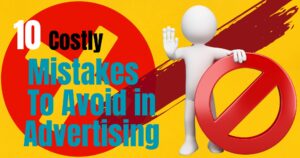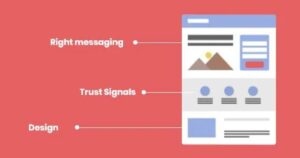
Advertising campaigns are essential for any business seeking to increase visibility and attract more potential customers. But advertising can be tricky. If you do it well, you’ll benefit from expanding sales and brand recognition. However, if done incorrectly, you could end up wasting a lot of time and money with little to show for it. In this article, we’ll go through some of the mistakes you need to avoid in your advertising campaigns.
1. Not understanding the target audience

Advertisements that are not aimed at the targeted audience may not empathize with them, resulting in low engagement and poor conversion rates. As a result, you should have a clear understanding of who your target audiences are. When you’re planning your campaign, it’s important to take the time to research your targeted audience’s age, location, needs, likes, dislikes, and what motivates them. Once you’ve discovered this, you can personalize your ad campaigns to them precisely. But it’s also important to keep in mind that your target audience may change over time, so stay adaptable and adjust your campaigns accordingly.
Target can be done based on:
Demographics
Demographics stand for characteristics like age, gender, income, education level, occupation, and location. You can adjust your advertising campaigns by knowing the demographics of your target audience.
Interest
Interest refers to the hobbies, activities, and topics people are interested in and they can provide useful insights on the kinds of products or services they would be interested in acquiring.
Behavior
Behavioral targeting means the use of data and information about a user’s online behavior to offer them ads that are more relevant to their interests and actions. Retargeting, Lookalike targeting, and contextual targeting are done based on behavior.
2. Not considering the budget limitations

It’s important to have a clear understanding of the budget when creating campaigns to avoid overspending, which could hurt the company’s financial stability and profitability. A budget also allows businesses to identify and analyze various marketing options, allowing them to make better decisions about which channels to invest in. For example, companies may choose to invest more in digital promotion, such as social media or search engines.
3. Neglecting the sales funnel

A sales funnel is the step-by-step process used by a business to convert its potential customers into actual customers. By understanding the position of a customer in the sales funnel, advertisers can modify their content and strategies to drive a customer closer to a purchase. Neglecting the sales funnel in advertising can result in a less effective marketing campaign with lower conversion and revenues. Not understanding the sales funnel may also result in wasted ad spend or a lower return on investment.
Awareness
The major goal of this stage is to create awareness of your brand among potential clients. This may be achieved through social media posts and campaigns, YouTube videos, search engine results and google ads, content marketing, influencer campaigns, email marketing, and events.
Interest
Potential customers may become interested in your products or brand after being aware of it. They might browse your web presence, read your blog post and follow you on social media. You need to run drip campaigns, and social media campaigns, and provide useful content such as eBooks and videos to keep them interested in your products and brand.
Decision
Potential customers are considering buying your products or services. They might be doing research, reading reviews, or making comparisons between your product and others. Giving potential clients the knowledge, they need to decide whether to buy anything is the aim of this stage. You can also offer new customers promotions, bonuses, trials, and other incentives to encourage them to purchase your products or services.
Action
This is the final stage of the sales funnel where potential customers decide to make a purchase. You need to make your purchase as easy as possible through a variety of approaches like special offers, multiple payment options, and smooth checkouts. Even after they have purchased from you, create customer retention by providing excellent customer service, personalized experience, ongoing support, and education so that they will buy from you again in the future.
4. Not conveying Brand awareness

Brand awareness is a major marketing strategy that helps to build your brand’s identity, create an image of a brand in the minds of potential customers, and stand out your company among competitors. If you do not include your brand in your advertising, you may miss out on the opportunity to connect with your target audience which could result in decreased brand recognition and lower sales. Whereas consistent branding across all marketing channels can help potential customers build trust and credibility that leads to increased loyalty and long-term success.
5. Not creating a proper landing page

Landing pages are the pages where the target audience is directed after clicking on an ad and not providing attention to them can lead to low engagement and conversion rates. A landing page should be customized to meet the specific requirements of the target audience, such as providing additional information about the product or service, an offer, or a clear call to action. Failure to do so can lead to wasted ad spend and a negative impact on the brand’s reputation.
6. Lack of advertisement competency

Lack of advertisement competency refers to a situation in which a person or company lacks the necessary skills, knowledge, or resources to create engaging and effective advertisements capable of attracting the target audience and achieving their marketing objectives. This can result in poor performance and lower return on investment (ROI) of advertising campaigns. Furthermore, reviewing ad performance metrics regularly and making data-driven decisions to optimize ad campaigns can help increase the effectiveness of campaigns. To avoid this situation, advertisers must have both technical and strategic expertise in advertising mechanisms.
7. Providing too much information and text.

When creating effective marketing content, it is important to use clear, concise, and simple language and eye-catching visual elements to make the message easy to understand and remember. It will also help to capture the attention of the target audience and get the desired result of your campaigns. Clear language means using understandable language and avoiding complex words. Images, graphics, and videos are also important components of effective ad content which helps in breaking up long paragraphs of text, making the content more visually appealing and readable.
8. Failing to provide a clear call-to-action

A call-to-action (CTA) is a phrase or button that encourages the viewer to act right now. A clear call-to-action gives the target audience a simple and clear next step, such as visiting a website, purchasing something, or signing up for a service, making it a crucial component of advertising. For example, a CTA that says, “Buy now” or “Sign up for a free trial” is straightforward and leaves no room for confusion. A well-designed CTA should also be visually pleasing and positioned in a noticeable area to draw the viewer’s attention.
9. Being irrelevant and boring

Advertising must be entertaining, relevant, and engaging to the target audience to encourage people to take action. People are more likely to watch and remember an entertaining and enjoyable advertisement than one that is boring. An advertisement that is relevant to the target audience is more likely to be seen as important and credible and thus receive more attention. An engaging advertisement encourages people to take action, such as making a purchase or visiting a website.
Not tracking results

One of the most common mistakes people make while running ad campaigns is not tracking the results. You won’t know what is working and what isn’t if you don’t follow the results of your campaigns. This may result in missed opportunities to earn profit from effective advertisements as well as money wasted on ineffective ads. Tracking tools like Google Analytics and Facebook Ads Manager are available for tracking metrics like click-through rates (CTRs), conversion rates, and cost per acquisition.
Conclusion
Businesses require advertising campaigns to market their brands and draw in customers, yet numerous frequent mistakes can prevent success. Businesses need to understand their target market, budget, and sales funnel, create brand awareness and a proper landing page, and must have advertisement expertise to avoid these mistakes. Keeping all these in mind, businesses can design campaigns that successfully reach their target audiences and fulfill their marketing objectives.


